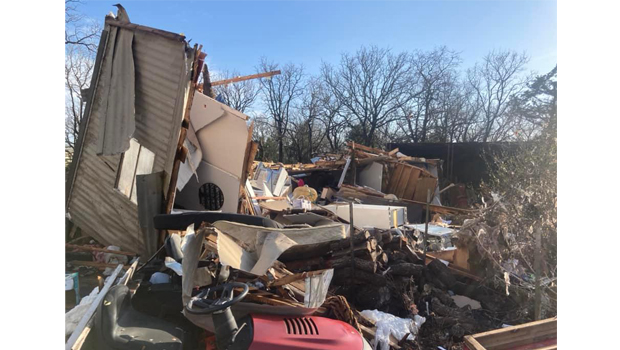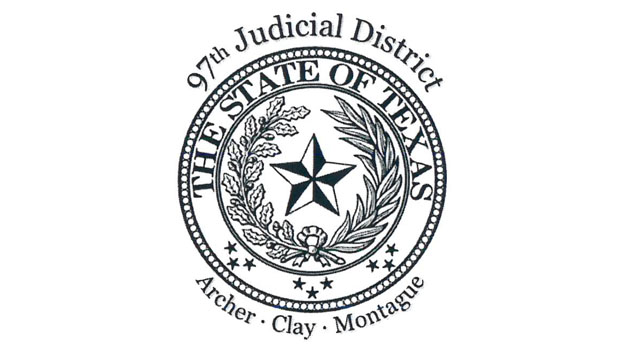NEWS
March record month for tornadoes across the southern states

By Adriana Navarro,
AccuWeather staff writer
The month of March across the contiguous United States ended as it began: stormy. As the seasons clashed and spring fought to overtake winter, the tumultuous pattern sparked numerous severe weather events across the nation. When the final tally is in, March 2022 very well could set a record for the most tornadoes ever in the month of March across the U.S. since record-keeping began.
AccuWeather forecasters say global warming could be one factor behind the exceptional number of tornadoes in March.
Montague County was the site of three separate EF-1 tornadoes on March 21 which caused major damage across the area.
At least 253 preliminary tornado reports were recorded throughout March 2022, according to the latest count from the Storm Prediction Center. While the number is preliminary, only 193 of the reports need to be confirmed as actual tornadoes to break the record of 192 confirmed tornadoes in 2017, according to the National Climatic Data Center. Records date back to 1950, though the numbers for 2020 through 2022 are preliminary.
The devastating storms that charged through the Midwest on the weekend of March 5, claiming the lives of at least seven people, served as a precursor to what the rest of the month would look like. It was during this storm that an EF4 tornado spawned, tearing through Winterset, Iowa, and killing six people, including four members of one family. This was also the storm during which the National Weather Service experienced a dissemination delay with their products, impacting the delivery time of tornado warnings.
While an NWS spokesperson said the service was still able to get the warnings out ahead of each tornado and had communicated the warning roughly 20 minutes before the tornado tore through Winterset, the technical difficulty was noted by U.S. lawmakers who days later introduced the TORNADO act.
Severe weather continued to spawn tornadoes, damaging wind gusts and hail throughout the month as the jet stream dipped into the south-central U.S., pulling moisture from the Gulf Coast northward, according to AccuWeather Chief Broadcast Meteorologist Bernie Rayno.
Cold intrusions from the north and desert air coming in from the west over the South Central states met abundant Gulf moisture, sparking the severe weather that residents in the area witnessed during March.
While many of the storms spawned a tornado or two throughout the month, the next outbreak sizeable in comparison to that at the beginning of the month didn’t come until March 21 to March 22 when severe weather charged through Texas and continued eastward.
This round of severe weather may bring to mind the video of a red truck tossed about in a tornado, accounts of two heavily damaged schools with no fatalities and the image of a huge tornado looming over New Orleans.
The storm claimed at least five lives, including that of a 73-year-old woman in the Grayson County community of Sherwood Shores in North Texas, a 25-year-old man in the New Orleans suburb of Arabi and three motorists in Holt, Alabama, who were found in their car, submerged in floodwaters.
For most of March, the contiguous U.S. didn’t go more than three days without a report of a tornado touching down, according to the Storm Prediction Center. Then, following March 23, there were five relatively calm days — the longest the month had gone without having a tornado report.
As the old adage in the weather business goes, though, the storm was not far behind.
A second round of severe weather soon struck not just the South but also the Midwest and Northeast the following week from March 29 to March 31, with at least 55 tornadoes confirmed across 13 states.
Unusually warm water in the Gulf of Mexico may have had a role in these previous two outbreaks, according to AccuWeather Chief Meteorologist Jonathan Porter.
“AccuWeather meteorologists noted unusually warm water off the Louisiana coast prior to the tornado outbreak on March 22, which included multiple tornadoes that struck the New Orleans areas,” Porter said.
AccuWeather meteorologists have been monitoring higher-than-normal water temperatures in the Gulf of Mexico over the last several years, especially for their relevance in the rapid intensification of hurricanes, including Laura and Ida, he added.
This warm water may have also played a role in providing additional low-level moisture, increasing the likelihood of tornadoes during the two severe weather events at the tail-end of the month as the company’s meteorologists have previously indicated may have contributed to the historic tornado outbreaks of December 2021 across the Central and Southern states.
While the waters off the Louisiana coast cooled slightly following the storms of March 22, warm water still existed farther east off the coast of Mississippi and Alabama and continued to warm prior to the outbreak on March 30, Porter said.
Increasing low-level winds in the atmosphere added another factor into the mix on March 30 when they transported this moisture-laden farther north into Mississippi and Alabama.
“Deep low-level moisture is one of the ingredients needed to produce tornadoes, and given our analysis of the rich low-level moisture — which was more than computer forecast models had predicted — [that was] present, we communicated the even greater tornado risk expected over Alabama and Mississippi during the evening on March 30 as low-level moisture increased as well as other atmospheric parameters becoming more favorable for tornadoes,” Porter said. “We suspect this unusually warm water was one of the key reasons there were more tornadoes further south and east, as far east as the Florida Panhandle during the March 30 outbreak when compared to March 22.”
Of the 72 filtered preliminary tornado reports from the Storm Prediction Center for that day, at least 28 had been reported in Mississippi and 21 in Alabama. The rest of the reports were scattered across Louisiana, Florida, Arkansas, Texas, Tennessee and even reached as far north as Indiana.
While there are other contributors to the higher-than-normal water temperatures in the Gulf of Mexico, Porter said that global warming remains a significant factor as the oceans are a heat sink — or a place the earth system stores excessive heat.
“A warming atmosphere is increasing, resulting in warming oceans all around the world, including the Gulf of Mexico,” Porter said. “While this has wide-ranging implications, one impact has already been seen – in the right conditions, warmer waters can contribute to increasing the risk for tornadoes well away from the ocean.”
NEWS
Bowie School Board swears in two members

By BARBARA GREEN
[email protected]
Trustees of the Bowie Independent School District welcomed one new member this week following the Nov. 5 election and accepted the 2023-24 outside audit with no exceptions.
Incumbent Trustee Jacky Betts returned to place one and Angie Christmas took the place two seat. After the board officers were dissolved with the new ones taking the oath, officers were elected. Betts will continue as president, Guy Green as vice president and Kent Dosch as secretary.
Paul Fleming of Edgin, Parkman, Fleming & Fleming, PC, presented the audit telling there were no issues and the process went smoothly. He noted the biggest change was the Legislature compressing the district tax rate and additional changes in the tax law. State aid formula grants increased due to the state’s funding formula compensating for lost property tax revenue due to the law change previously mentioned.
Read the full story in the weekend Bowie News.


NEWS
ER/hospital steering group formed

By BARBARA GREEN
[email protected]
Information was the watchword for the second hospital/emergency room community meeting Tuesday night, as the steering committee was announced along with additional financial considerations.
About 50 people attended the meeting. Melody Gillespie, who was named chairperson for the committee, said the goal is to gather information to get it out into the community. This group was formed after the Bowie emergency room was closed by Faith Rural Health System in early October just shy of one year of operating in Bowie.
Kylie Ward, one of the public relations volunteers, said, “This committee is not here to force things on you and there are assumptions already we are proposing a tax. We are not, we don’t have that ability, we are just a research team here to explore all the options.”
Other members of the committee include Tiffany Chandler and Damon Benton handling finance and grant research; Jennifer Tellef, secretary; Valerie Tomerson, grant research; Ann Smith, PR and Margin Latham and Gillespie, legislative research. It was pointed out there are other members of the sub-committees who are helping with research, but they also invite anyone interested to help with the process.
Read the full story in the weekend Bowie News.
Top photo – Jack County Judge Keith Umphress spoke at this week’s steering committee meeting. (Photo by Barbara Green)
NEWS
Montague County Grand Jury issues November indicted cases

The following indictments were filed with the 97th District Clerk following the November session of the Montague County Grand Jury.
There were a total of 13 indictments with one sealed awaiting the arrest of a suspect.
A grand jury indictment is not evidence of guilt. All defendants are presumed innocent until proven guilty beyond a reasonable doubt in a court of law.
Read the full list of indictments in your mid-week Bowie News.
-

 NEWS2 years ago
NEWS2 years ago2 hurt, 1 jailed after shooting incident north of Nocona
-

 NEWS1 year ago
NEWS1 year agoSuspect indicted, jailed in Tia Hutson murder
-

 NEWS2 years ago
NEWS2 years agoSO investigating possible murder/suicide
-

 NEWS2 years ago
NEWS2 years agoWreck takes the life of BHS teen, 16
-

 NEWS1 year ago
NEWS1 year agoMurder unsolved – 1 year later Tia Hutson’s family angry, frustrated with no arrest
-

 NEWS2 years ago
NEWS2 years agoSheriff’s office called out to infant’s death
-

 NEWS2 years ago
NEWS2 years agoBowie Police face three-hour standoff after possible domestic fight
-

 NEWS2 years ago
NEWS2 years agoDriver stopped by a man running into the street, robbed at knifepoint





